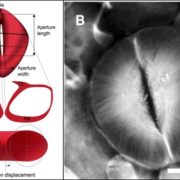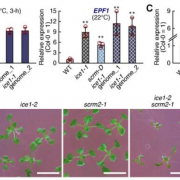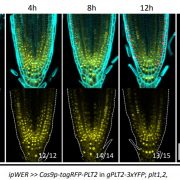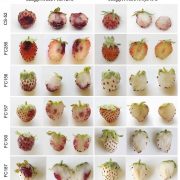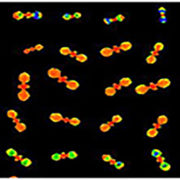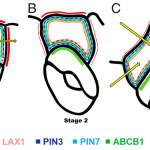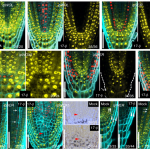An optogenetic tool for plants grown in ambient light (Nature Methods)
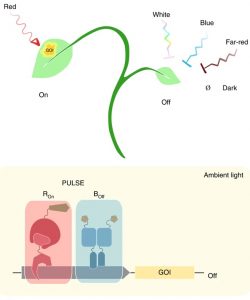 Optogenetics has revolutionized mammalian biology by its ability to fine-tune gene expression in individual cells by pulses of light. However, its application in plants has been challenging because the white light required for plant growth misfires the system. Ochoa-Fernandez et al. solved this problem by engineered photoreceptors that can repress and induce gene expression driven by blue and red light, respectively. The system, termed plant usable light-switch elements (PULSE), allows quantitative and spatiotemporal reversible control of gene expression without being influenced by the broad-spectrum of white light. To guide experimental conditions, the authors developed a quantitative model that predicts PULSE activity. The authors devised two strategies to control gene expression: 1) inducing and targeting a transcriptional activator to the promoter region of the gene of interest using Cas9 and guide RNA and 2) inducing a plant endogenous transcription factor that controls expression of its target genes. They demonstrated that an optogenetically-induced immune receptor could control plant immune responses in Nicotiana benthamiana transiently transformed with PULSE. They also applied this system to conditionally localize proteins to a specific sub-cellular domain of the cell using nanobodies that have a high affinity to particular proteins. Finally, they showed PULSE is functional in stable Arabidopsis transgenic lines. This new tool facilitates the precise manipulation of biological processes in plants to address fundamental questions in plant biology. (Summary by Tatsuya Nobori @nobolly) Nature Methods 10.1038/s41592-020-0868-y
Optogenetics has revolutionized mammalian biology by its ability to fine-tune gene expression in individual cells by pulses of light. However, its application in plants has been challenging because the white light required for plant growth misfires the system. Ochoa-Fernandez et al. solved this problem by engineered photoreceptors that can repress and induce gene expression driven by blue and red light, respectively. The system, termed plant usable light-switch elements (PULSE), allows quantitative and spatiotemporal reversible control of gene expression without being influenced by the broad-spectrum of white light. To guide experimental conditions, the authors developed a quantitative model that predicts PULSE activity. The authors devised two strategies to control gene expression: 1) inducing and targeting a transcriptional activator to the promoter region of the gene of interest using Cas9 and guide RNA and 2) inducing a plant endogenous transcription factor that controls expression of its target genes. They demonstrated that an optogenetically-induced immune receptor could control plant immune responses in Nicotiana benthamiana transiently transformed with PULSE. They also applied this system to conditionally localize proteins to a specific sub-cellular domain of the cell using nanobodies that have a high affinity to particular proteins. Finally, they showed PULSE is functional in stable Arabidopsis transgenic lines. This new tool facilitates the precise manipulation of biological processes in plants to address fundamental questions in plant biology. (Summary by Tatsuya Nobori @nobolly) Nature Methods 10.1038/s41592-020-0868-y


